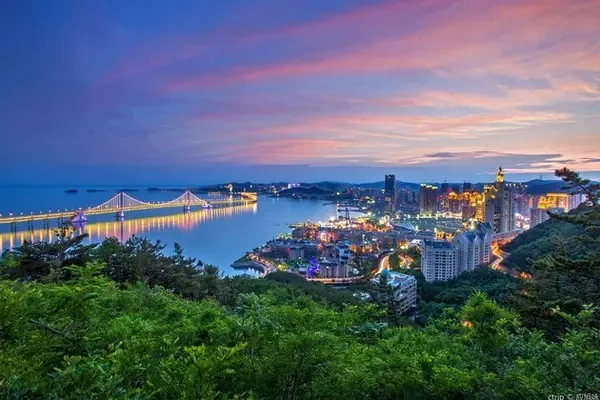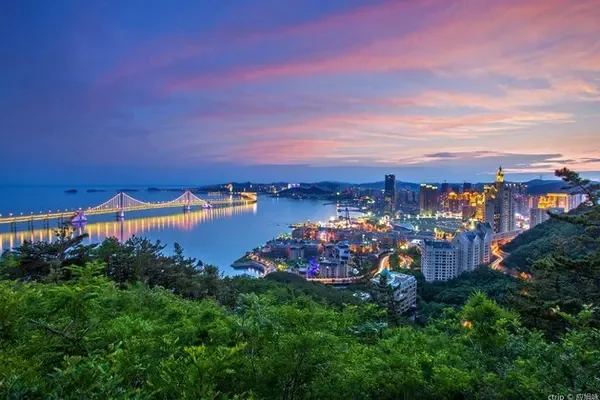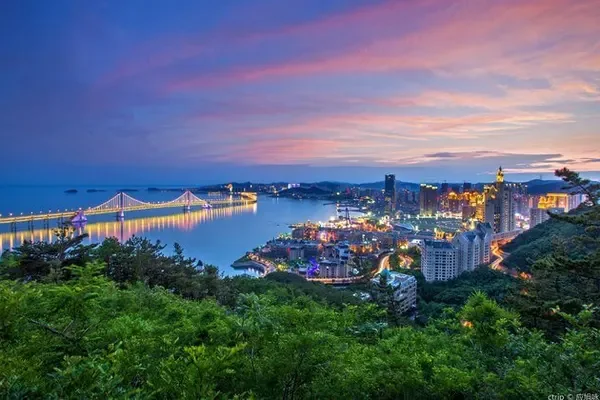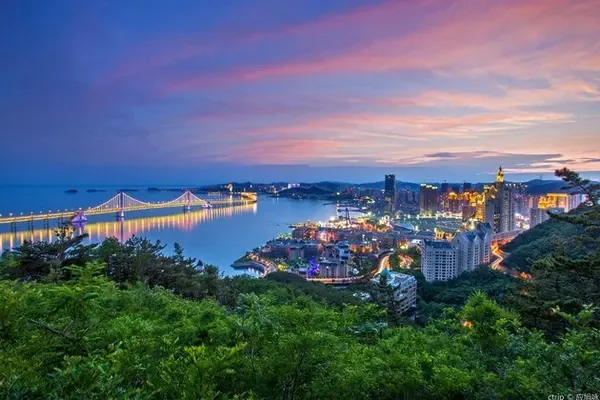On the first day of February (Sunday) of the Dingyou Year, we were invited by friends to come to Lishui. The golden rooster sings the dawn, and the sunny day in early spring makes us feel relaxed and happy. We visited Zhou Garden, and there are poems to prove it:
The treasures of the world are collected in Zhouyuan,
Unintentionally enjoy the eyes to appreciate,
A treasure and a story,
Take a closer look.

Zhou Garden is located in Baima Town, Lishui District, Nanjing City. It is the largest private collection in China. It was built by Mr. Zhou Hetong, a British Chinese. The theme of the Zhou Garden is Buddhist culture and Huizhou architecture. The Zhou Garden is an antique building in the style of the Forbidden City, covering an area of more than 100 mu. At present, there are countless museums all over the world, but there are very few representative private collections. There are nearly 10,000 collections of five generations of the Zhou family in the Zhou Garden, but according to the person in charge of the Zhou Garden, this is only a quarter of the collections stored by the Zhou family at home and abroad. Shangshufang, Hundred Buddha Hall, Hall of Mental Cultivation, Lion Dragon Hall, Taihe Zhai, Baohe Zhai, Thousand Buddha Gallery, Hundred Bed Hall, Root Carving Hall, Stone Carving Group, Emblem Building Group, etc. Just like the auspicious "Ruyi", tourists seem to walk on Ruyi when they visit, implying that everything goes well, so Zhou Garden is also known as "White Horse Ruyi Culture and Art Center".

Entering the garden, you can see the mahogany bed king covering an area of 30 square meters, the single wooden table king with a tree age of more than 3,000 years, the dragon and phoenix inkstone weighing 6.5 tons, the rare yew tea sea, and more than 4,000 large and small stone Buddha statues. Large and exquisite hand-painted murals of multiple square meters. There are countless rare treasures everywhere... These rare treasures will shock your vision...

Walking into Zhou Garden, a mountain gate with four pillars and three floors of eaves carved with dragons and phoenixes stands in front of you. On the left side of the gate is a huge Nine Dragon Wall, and in front of the wall sit the nine sons of the dragon. In front of the mountain gate, the stone sculpture of the second general Hum Ha is not angry and arrogant.

The first scenic spot after entering the door is the "Thousand Buddha Gallery", a 318-meter long corridor, in which 1,000 Buddha statues of different periods, different sects and styles are enshrined. The staff said that these Buddha statues come from all over the country, and a small number of them are "purchased" from overseas, and the shipping cost alone costs tens of millions. Passing through the Thousand-Buddha Gallery is an open-air square. Many giant Buddha statues appear in front of our eyes, as well as stone tablets, Buddha statues and pagodas from various periods. Their scale and quantity amaze many well-informed visitors in China.


There are 199 standing Buddhas on the left, implying eternity. After walking the Buddhist path, you will enter the "Thousand-Buddha Corridor" scenic spot. There are exquisite Su-style colored paintings painted on the promenade. The contents of the colored paintings are different, telling Confucian classics and Taoist legends. These Buddhas were collected by Mr. Zhou Hetong's family from various places at home and abroad. Looking from one side of the corridor, thousands of Buddha statues and the red pillars of the corridor reflect each other, making them look sacred and solemn; There is a sense of tranquility in the corridor. Some of the Buddhas are enshrined by devout tourists, and they come to Zhouyuan to pray to the Buddhas on major festivals every year. The Buddha statues enshrined in different periods and in the Thousand Buddha Gallery are mainly stone Buddhas. From the shape, we can see the difference in the carving dynasties. The statues in the Northern Dynasties are rough and simple, the statues in the Tang Dynasty are plump and dignified, and the statues in the Song Dynasty are elegant. Beautiful; the Buddha statues here are really in different shapes, some are in the form of preaching Buddhism, and some are in the form of accepting the wishes of the people... The Nine Dragon Wall moved by the people of the Nine Dragon Stone Wall was cut into four sections at that time.

Kowloon Stone Wall

The Zhou Garden takes Buddhism as the theme, and various Buddha statues are scattered in every corner of the Zhou Garden. There are more than 4,800 stone Buddha statues in the entire Zhou Garden. There are more than 1,300 Buddha statues. Walking through it is very shocking.

The descendants of Fu Lu Shou and Shibi are all blessed, and the family enjoys happiness.


stone wall

The collected stone Buddha statues are placed everywhere. It is said that a lot was collected when the Three Gorges was relocated.



reclining buddha



After looking for incense, I entered the root carving hall. The sculpture has a sense of three-dimensional space, which is different from the two-dimensional painting. In terms of form, it can be divided into relief sculpture and round sculpture. Relief sculpture is generally viewed from one side, while round sculpture can be viewed from four sides or even multiple sides. There are more than 80 large-scale wood carvings here, among which the single wooden table king with a tree age of more than 3,000 years is even more shocking. It is carved from Brazilian rosewood for thousands of years. The surface is as smooth as jade, and the texture is clearly visible. Strolling in the root carving hall, the camphor fragrance is fragrant. Many root carvings are made of camphor wood. You can smell a very comfortable aroma when you get close to it, giving people a sense of peace and tranquility. Wood Carving Root Carving Hall

3000-year-old wooden table king

lifelike

Nine Lion Dance Hydrangea

One hundred and eight camphor wood carvings


Gold powder Yang engraved scripture root carving

In Shangshufang, there are some couplets hanging on the back wall of the room. The Four Treasures of the Study Room, Camphor Wood Tea Sea, and Root Carved Chairs are all eye-catching. The desk facing the door is said to be carved from a rosewood tree more than a thousand years old. It is matched with a seat carved from banyan tree roots and a sea of tea made of camphor wood. The whole study looks antique. Adjacent to the imperial dining room is the Baifo Hall, where Mr. Zhou Hetong worships the Buddha. There are more than 100 Buddha statues enshrined in the hall. There is a nine-level stone pagoda carved in the middle, and a long-lived turtle listening to Buddhism is lying in front of it. A few steps forward from Baifo Hall is Yangxin Zhai, the place where you can cultivate your mind and cultivate your character. This is the master's bedroom. The extremely luxurious sour branch wood babu room is carved with jade dragons, sometimes baring its teeth and dancing its claws, sometimes flying through the clouds; under the bed is a tiger skin, which shows the king's demeanor, which is really admirable. But the most surprising thing is the inconspicuous floor tiles in the bedroom. The tour guide of the park said that the floor tiles of Yangxinzhai are all two-foot-square bricks unique to the Forbidden City in Beijing. They were originally made in Suzhou and transported through the Suzhou-Hangzhou Grand Canal. The capital is a unique decorative brick for the palace, and it is hard in texture and makes a metal-like sound when knocked. The craftsmanship of this kind of brick is a unique Chinese art. It is called "breathing brick". The value is equivalent to a thousand taels of gold, which can be described as "a brick of gold". In the Shangshu room filled with the fragrance of ink and wood, the four treasures of the study are priceless. The black dragon and phoenix inkstone on the left hand side weighs 6.5 tons. There are 27 dragons and 2 phoenixes carved on it, implying the prosperity of the dragon and phoenix. The desk is also made of a thousand-year-old tree. carved.


Bedroom, tiger skin, a pair of jade animals in front of the bed

Buddhist hall

Taishi chair + fur

Brown is the dragon and phoenix inkstone, 6.5 tons

stump chair, many appliances

Good luck

Jade

Zhouyuan jade carvings are also priceless, all carved from nephrite jade in Xinjiang. It is not easy to collect one piece, and it is even rarer to collect a set. It can be seen that the owner, Mr. Zhou, has spent a lot of effort and financial resources. Among them, there are 18 arhats. Jade carvings are round and white in quality; a piece of Nine Dragons jade carving carved from whole jade has nine flying dragons with majestic momentum, flying in front of your eyes, just like the reappearance of real dragons, just like life.









rebound lute

Hetian Jade Arhat

Walking up the steps from Yangxinzhai, there is a two-story, five-bay hall with double eaves on the top of the mountain, a magnificent and resplendent hall. The dragon is a symbol of authority and dignity; the lion is a guardian animal. Chinese people like lions and dragons. The owner of Zhou Garden is a British Chinese, so he has a special liking for "lions and dragons", so it is named "Lion and Dragon Hall". This is the owner's living room, which contains countless rare treasures. When the foundation was laid, a valuable jade toad was buried under the foundation. The toad has always been regarded as an auspicious thing for attracting wealth, attracting gold and wealth, and warding off evil spirits. Chen Wanbao in the Lion and Dragon Hall, the golden plaque of "Five Generations of Prosperity" tells people that there are private collections of five generations of Zhou's family gathered here. The golden dragon coiled on the red-bottomed dragon pillars in the hall, the murals on the surrounding walls and ceilings, the hand-painted architectural paintings, and the seal paintings and decorative patterns are all drawn one by one by skilled craftsmen who have been invited to restore the Forbidden City. All are mineral materials, for example, the green one is malachite, the yellow one is stone yellow, and the red one is cinnabar. It can be preserved for a hundred years indoors, and it can be preserved for 70 years outdoors without fading. It is beautiful and brilliant.


In the Lion and Dragon Hall, there is a lion and dragon table in the middle, 3 tons, which is the female table. In the center of the Lion Hall is a large round table made of rosewood, bought by Mr. Zhou from a wealthy family in Tianjin, with two pots of Ganoderma lucidum placed on it. In the hall, there are several cases enshrining Guanyin Bodhisattva, with bells and bottles, implying "final (bell) body (bottle) peace". The two treasure chests of the same form displayed in the hall are one of the most valuable collections in the Zhou Garden. The multi-treasure cabinet is made of rosewood to imitate bamboo products, and the exquisite carving is amazing. It is said that this multi-treasure cabinet was built in the reign of Cixi. The phoenix on the top of the cabinet looks like it is about to fly, and the bottom is a dragon, which symbolizes the era of the Qing Dynasty's empress dowager. The lion and dragon table is the "treasure of the garden" in Zhouyuan. This sour branch wood cloud dragon pattern inlaid jade waist and three curved animal feet table, 3.2 meters long, 1.2 meters wide, 1 meter high, and weighs 3 tons. "It took more than two hours for more than 20 great guys to put it up." The staff said, "Lion Dragon Hall" is also named after this. In fact, its preciousness lies not only in its large size and weight, but also in its exquisite craftsmanship and culture, which make it loved by its owner. At the same time, the treasure of the town house, the jade toad, is buried in the foundation of the Lion Hall. The overall momentum of the building and display is not inferior to that of the royal family at all.

There is a unicorn squatting on each side of the lion and dragon table. It is a kind of mythical beast that is very popular among the people. The good reputation of "children, kylins send blessings, and kylins send wealth". On the tables in the hall, there is enshrined Jade Guanyin Bodhisattva, with his right leg bent and his left leg bent but not bent, sitting on a lotus throne, sacred and solemn. The location of the Jade Guanyin Bodhisattva is also very special. It is directly facing the orbs of Erlong Xizhu on the ridge of the imperial dining room opposite. There are also clocks and bottles on the table, which means "final (bell) life (bottle) safety". Jade toad, lion and dragon table, and Jade Guanyin are collectively known as the "Three Treasures of Zhouyuan Town House". The two treasure chests of the same style displayed in the hall are one of the most valuable collections in the Zhou Garden. The multi-treasure cabinet is made of rosewood to imitate bamboo products, and the exquisite carving is amazing. The imitation bamboo embodies the ancient people's love for bamboo, which is "I would rather eat without meat than live without bamboo". It is said that this multi-treasure cabinet was built in the reign of Cixi. The phoenix on the top of the cabinet looks like it is about to fly, and the bottom is a dragon, which symbolizes the era of the Qing Dynasty's empress dowager. The function of the multi-treasure cabinet was used by the ladies of the ancient rich families to store gold, silver and jewelry.

There is a Guanyin statue carved from camphor wood on the right side of the stairs. The finishing touch of this wood carving is the Yang engraved scriptures on the upper right, coated with a layer of gold powder, which looks noble and generous. Walking up the stairs slowly to the second floor, a woodcarving of eighteen arhats is particularly eye-catching. Three parts are man-made and seven parts are natural. The bottom retains the original tree roots. The carving is exquisite. The beard, eyebrows and pores of the arhat are clearly visible. Following the wood carvings one by one, there is a pair of unobtrusive screens next to it. When you look closely, you find that there is a lot of mystery in it. It is carved from a whole piece of jade, and there are 101 "shou" characters carved on it. The writing method of each character is It is different, and the larger character "Shou" in the middle seems to be composed of the three characters "Old and Young" from top to bottom. The collections in the entire Lion Dragon Hall are dazzling and eye-opening.

Jade puzzle screen


Mahogany carved, a door a story

A total of 2008 jade lions are inlaid




A carved wooden chair inlaid with jade.



This is no ordinary drum, this is a Tibetan human skin drum.

Murals in Lion Hall

The antique paint murals on both sides of the foyer have meanings

Old objects, allegorical patterns

Baishou Screen in the Lion Hall

The Lion Dragon Hall is the master's living room, which has two floors. There are countless rare treasures inside. Under the foundation, there is a priceless jade toad. The toad is an auspicious thing with three legs. The function of absorbing gold and making money to transform evil spirits. This table is the same mother-in-law table as the one in the imperial dining room.

The Hundred Beds Pavilion contains more than 120 ancient beds. Four-poster beds, six-poster beds... There are many styles, most of which are made of mahogany, which are very well preserved and collected from various folks.

The exquisite murals on the walls of the Hundred Beds Pavilion are made by the craftsmen of the Forbidden City. The most exciting painting is "Chaoyuan Picture", also known as "Yongle Palace Picture". The entire mural covers a total area of 1,000 square meters, with a total of 286 gods painted. It is a large-scale pilgrimage lineup.

This small room is actually a bed, known as the king of beds. This bed was specially made for Puyi, the last emperor of the country, by a local furniture manufacturer when he was in distress in Tianjin. The whole bed is 6 meters long, 5 meters wide, and 2.8 meters high, covering an area of 30 square meters. Someone once was willing to bid 80 million to buy it, but now the value is incalculable.

King bed room


Vertical style bed



lecture hall

Tibetan Buddhist Items


Brilliant


Emperor's Throne Seat

Zhou Yuan's meeting room is also very noble and domineering. This long solid wood table and the chair that can only be lifted by four people amazed everyone.



Zodiac stone pillars, very cute!


After watching the cultural and art exhibition area, walk through the promenade and come to the courtyard-style Hui culture experience center. According to the introduction of the park tour guide, Mr. Zhou Hetong has collected more than 40 Hui style buildings in the Jiangxi area of Anhui. He bought the whole house first, and then dismantled the wood, stone, bricks and tiles one by one, and transported them to Zhou Baima Town, Lishui District. On the side of the garden, find skilled craftsmen to restore it again. At present, due to the limited area of the Zhou Garden, only five Huizhou buildings have been placed, and the rest will be placed in the fourth phase of the Zhou Garden. These buildings are divided into official residences and commercial residences, with different appearances and interior decorations, reflecting their respective identities and styles. There is a sculpture in the shape of an official hat on the ridge of the official house, the windows on the outer wall are "rice-shaped", and two stone lions sit at the door. Stepping into the official house and looking up, there is a patio, which is used for ventilation and lighting, and also has the meaning of gathering wealth. When it rains, the rainwater falls into the pool through the patio, and is led to the hall behind the courtyard through a special drainage channel, implying "the four waters return to the bright hall, and the fertile water does not flow out." The commercial house next door looks more grand than the official house. The windows on the outer wall are in the shape of copper coins. The interior decoration is more luxurious, and the patterns carved on the wall are also unique. It means that as a businessman, the mind should be smooth, and the octagonal shape below implies wealth from all sides and exquisiteness on all sides. These two buildings have two courtyards, which are divided into front hall and back hall, and the second floor is a wing room, which basically fully shows the characteristics of Huizhou architecture.

The following are the original relocated Huizhou buildings


octagonal patio

Courtyard of the official residence






Weipai Pavilion



The spring is warm and the flowers are blooming in Lishui. Walking in Lishui, Yunshui Zen mind to watch Zhou Garden, with various poses and different forms, unique in the world, lingering and forgetting to express poetic feelings. Due to my shallow culture, I pay more attention to novelty, which is the same as when I visited the Potala Palace and shouted: "A lot of gold". Therefore, this travel note is just an introduction. Friends who are interested in cultural relics, furniture, sculpture, Buddhism, etc., please don’t scold me for throwing away watermelons and picking sesame seeds, and returning empty-handed after entering Baoshan. If you can learn from this travel note that there is Zhouyuan, the largest private museum in China, in Nanjing, then my goal will be achieved.




